5.15 Genetic Disorders

Polly Who?
Each hand in the Figure 5.15.1 photo has an extra pinky finger. This is a condition called polydactyly, which literally means “many digits.” People with polydactyly may have extra fingers and/or toes, and the condition may affect just one hand or foot, or both hands and feet. Polydactyly is often genetic in origin and may be part of a genetic disorder associated with other abnormalities.
What Are Genetic Disorders?
Genetic disorders are diseases, syndromes, or other abnormal conditions caused by mutations in one or more genes, or by chromosomal alterations. Genetic disorders are typically present at birth, but they should not be confused with congenital disorders, a category that includes any disorder present at birth, regardless of cause. Some congenital disorders are not caused by genetic mutations or chromosomal alterations. Instead, they are caused by problems that arise during embryonic or fetal development, or during the process of birth. An example of a nongenetic congenital disorder is fetal alcohol syndrome. This is a collection of birth defects, including facial anomalies and intellectual disability, caused by maternal alcohol consumption during pregnancy.
Genetic Disorders Caused by Mutations
Table 5.15.1 lists several genetic disorders caused by mutations in just one gene. Some of the disorders are caused by mutations in autosomal genes, others by mutations in X-linked genes. Which disorders would you expect to be more common in males than females?
| Genetic Disorder | Direct Effect of Mutation | Signs and Symptoms of the Disorder | Mode of Inheritance |
|---|---|---|---|
| Marfan syndrome | Defective protein in connective tissue | Heart and bone defects and unusually long, slender limbs and fingers | Autosomal dominant |
| Sickle cell anemia | Abnormal hemoglobin protein in red blood cells | Sickle-shaped red blood cells that clog tiny blood vessels, causing pain and damaging organs and joints | Autosomal recessive |
| Hypophosphatemic (Vitamin D-resistant) rickets | Lack of a substance needed for bones to absorb minerals | Soft bones that easily become deformed, leading to bowed legs and other skeletal deformities | X-linked dominant |
| Hemophilia A | Reduced activity of a protein needed for blood clotting | Internal and external bleeding that occurs easily and is difficult to control | X-linked recessive |
Very few genetic disorders are controlled by dominant mutant [pHypophosphatemicb_glossary id=”2119″]alleles[/pb_glossary]. A dominant allele is expressed in every individual who inherits even one copy of it. If it causes a serious disorder, affected people may die young and fail to reproduce. Therefore, the mutant dominant allele is likely to die out of a population.
A recessive mutant allele — such as the allele that causes sickle cell anemia or cystic fibrosis — is not expressed in people who inherit just one copy of it. These people are called carriers. They do not have the disorder themselves, but they carry the mutant allele and their offspring can inherit it. Thus, the allele is likely to pass on to the next generation, rather than die out.
Genetic Disorders Caused by Chromosomal Alterations
Mistakes may occur during meiosis that result in nondisjunction. This is the failure of replicated chromosomes to separate properly during meiosis. Some of the resulting gametes will be missing all or part of a chromosome, while others will have an extra copy of all or part of the chromosome. If such gametes are fertilized and form zygotes, they usually do not survive. If they do survive, the individuals are likely to have serious genetic disorders.
Table 5.15.2 lists several genetic disorders that are caused by abnormal numbers of chromosomes. Most chromosomal disorders involve the X chromosome. The X and Y chromosomes are the only chromosome pair in which the two chromosomes are very different in size. This explains why nondisjunction tends to occur more frequently in sex chromosomes than in autosomes.
| Genetic Disorder | Genotype | Phenotypic Effects |
|---|---|---|
| Down syndrome | Extra copy (complete or partial) of chromosome 21 (see Figure 5.15.3) | Developmental delays, distinctive facial appearance, and other abnormalities (see Figure 5.15.2) |
| Turner syndrome | One X chromosome but no other sex chromosome (XO) | Female with short height and infertility(inability to reproduce) |
| Triple X syndrome | Three X chromosomes (XXX) | Female with mild developmental delays and menstrual irregularities |
| Klinefelter syndrome | One Y chromosome and two or more X chromosomes (XXY, XXXY) | Male with problems in sexual development and reduced levels of the male hormone testosterone |
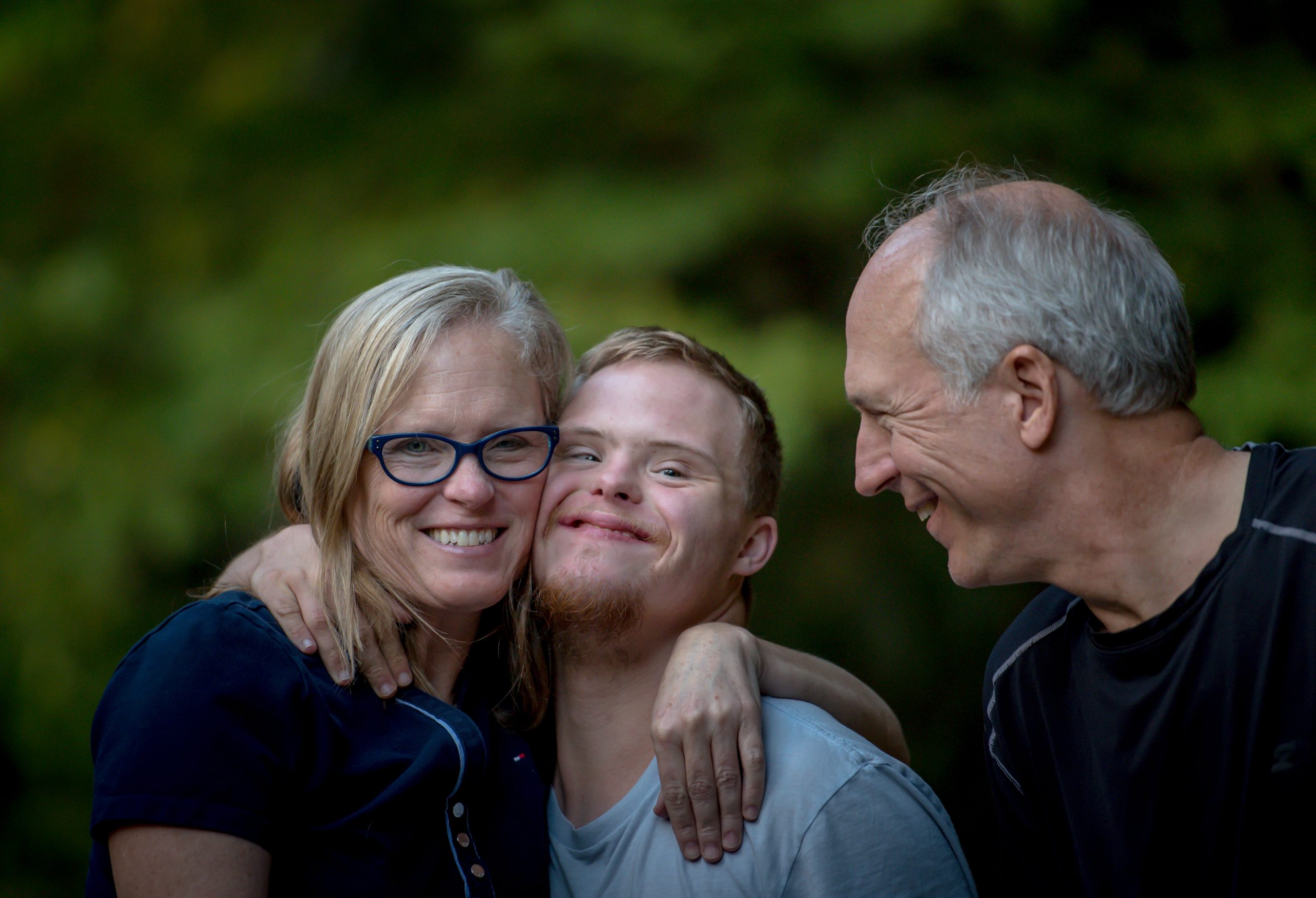 |
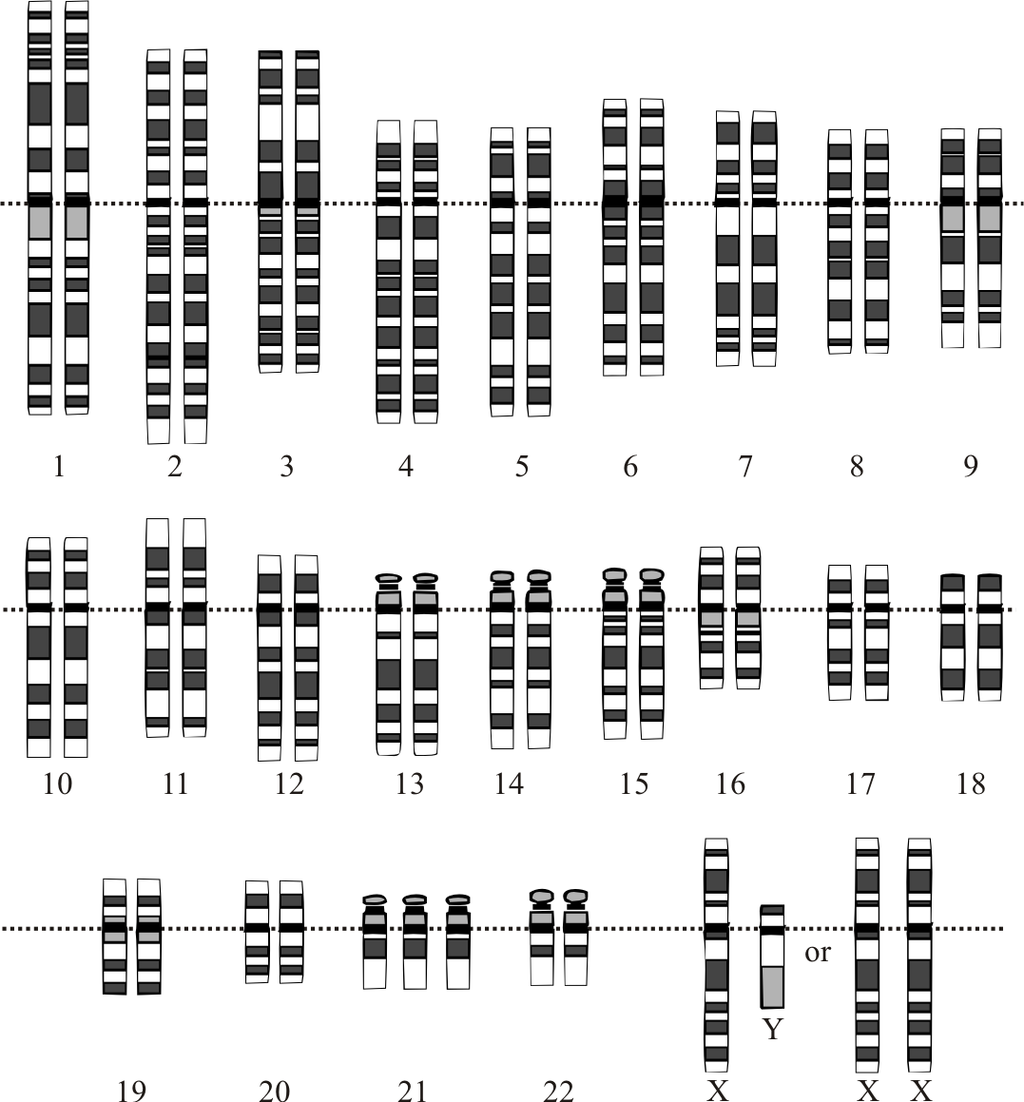 |
A karyotype is a picture of a cell’s chromosomes. In Figure 5.15.3, note the extra chromosome 21. In Figure 5.15.2, a young man with Down syndrome exhibits the characteristic facial appearance.
Diagnosing and Treating Genetic Disorders
A genetic disorder that is caused by a mutation can be inherited. Therefore, people with a genetic disorder in their family may be concerned about having children with the disorder. A genetic counselor can help them understand the risks of their children being affected. If they decide to have children, they may be advised to have prenatal (“before birth”) testing to see if the fetus has any genetic abnormalities. One method of prenatal testing is amniocentesis. In this procedure, a few fetal cells are extracted from the fluid surrounding the fetus in utero, and the fetal chromosomes are examined. Down syndrome and other chromosomal alterations can be detected in this way.
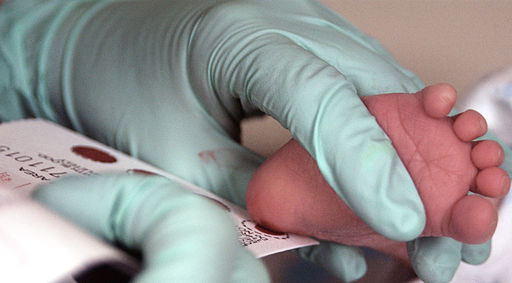
The symptoms of genetic disorders can sometimes be treated or prevented. In the genetic disorder called phenylketonuria (PKU), for example, the amino acid phenylalanine builds up in the body to harmful levels. PKU is caused by a mutation in a gene that normally codes for an enzyme needed to break down phenylalanine. When a person with PKU consumes foods high in phenylalanine (including many high-protein foods), the buildup of PKU can lead to serious health problems. In infants and young children, the build-up of phenylalanine can cause intellectual disability and delayed development, along with other serious problems. All babies in Canada and the United States and many other countries are screened for PKU soon after birth. As shown in Figure 5.15.3, the PKU test involves collecting a small amount of blood from the infant, typically from the heel using a small lancet. The blood is collected on a special type of filter paper and then brought to a laboratory for analysis. If PKU is diagnosed, the infant can be fed a low-phenylalanine diet, which prevents the buildup of phenylalanine and the health problems associated with it, including intellectual disability. As long as a low-phenylalanine diet is followed throughout life, most symptoms of the disorder can be prevented.
Curing Genetic Disorders
Cures for genetic disorders are still in the early stages of development. One potential cure is gene therapy. Gene therapy is an experimental technique that uses genes to treat or prevent disease. In gene therapy, normal genes are introduced into cells to compensate for abnormal genes. If a mutated gene causes a necessary protein to be nonfunctional or missing, gene therapy may be able to introduce a normal copy of the gene to produce the needed functional protein.
A gene inserted directly into a cell usually does not function, so a carrier called a vector is genetically engineered to deliver the gene (see Figure 5.15.4 illustration). Certain viruses, such as adenoviruses, are often used as vectors. They can deliver the new gene by infecting cells. The viruses are modified so they do not cause disease when used in people. If the treatment is successful, the new gene delivered by the vector will allow the synthesis of a functioning protein. Researchers still must overcome many technical challenges before gene therapy will be a practical approach to curing genetic disorders.
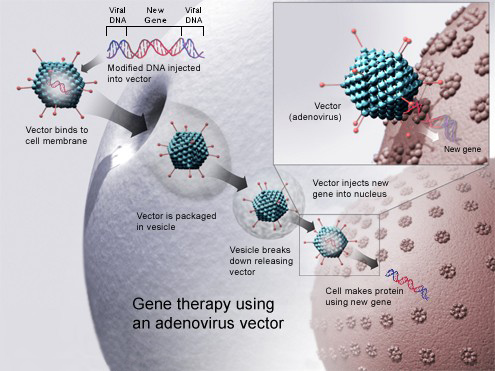
Feature: Human Biology in the News
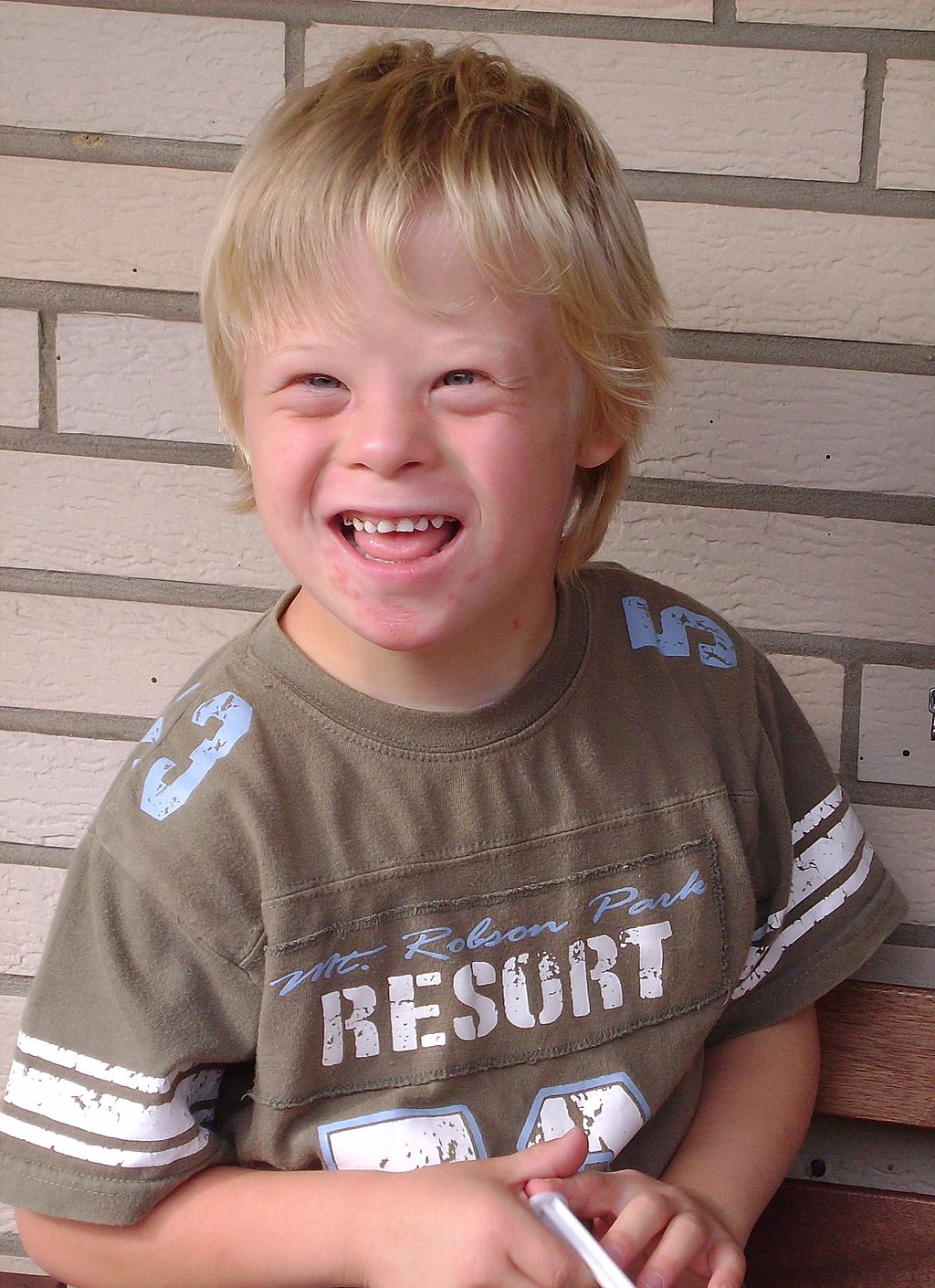
Down syndrome is the most common genetic cause of intellectual disability. It occurs in about one in every 700 live births, and it currently affects nearly half a million Americans. Until recently, scientists thought that the changes leading to intellectual disability in people with Down syndrome all happen before birth.
Even more recently, researchers discovered a genetic abnormality that affects brain development in people with Down syndrome throughout childhood and into adulthood. The newly discovered genetic abnormality changes communication between nerve cells in the brain, resulting in slower transmission of nerve impulses. This finding may eventually allow the development of strategies to promote brain functioning in Down syndrome patients, and it may also be applicable to other development disabilities, such as autism. The results of this promising study were published in the March 16, 2016 issue of the scientific journal Neuron.
5.15 Summary
- Genetic disorders are diseases, syndromes, or other abnormal conditions that are caused by mutations in one or more genes, or by chromosomal alterations.
- Examples of genetic disorders caused by single-gene mutations include Marfan syndrome (autosomal dominant), sickle cell anemia (autosomal recessive), vitamin D-resistant rickets (X-linked dominant), and hemophilia A (X-linked recessive). Very few genetic disorders are caused by dominant mutations because these alleles are less likely to be passed on to successive generations.
- Nondisjunction is the failure of replicated chromosomes to separate properly during meiosis. This may result in genetic disorders caused by abnormal numbers of chromosomes. An example is Down syndrome, in which the individual inherits an extra copy of chromosome 21. Most chromosomal disorders involve the X chromosome. An example is Klinefelter’s syndrome (XXY, XXXY).
- Prenatal genetic testing (by amniocentesis, for example) can detect chromosomal alterations in utero. The symptoms of some genetic disorders can be treated or prevented. For example, symptoms of phenylketonuria (PKU) can be prevented by following a low-phenylalanine diet throughout life.
- Cures for genetic disorders are still in the early stages of development. One potential cure is gene therapy, in which normal genes are introduced into cells by a vector such as a virus to compensate for mutated genes.
5.15 Review Questions
- Define genetic disorder.
- Identify three genetic disorders caused by mutations in a single gene.
- Why are single-gene genetic disorders more commonly controlled by recessive than dominant mutant alleles?
- What is nondisjunction? Why can it cause genetic disorders?
- Explain why genetic disorders caused by abnormal numbers of chromosomes most often involve the X chromosome.
- How is Down syndrome detected in utero?
- Use the example of PKU to illustrate how the symptoms of a genetic disorder can sometimes be prevented.
- Explain how gene therapy works.
- Compare and contrast genetic disorders and congenital disorders.
- Explain why parents that do not have Down syndrome can have a child with Down syndrome.
- Hemophilia A and Turner’s syndrome both involve problems with the X chromosome. In terms of how the X chromosome is affected, what is the major difference between these two types of disorders?
- Can you be a carrier of Marfan syndrome and not have the disorder? Explain your answer.
5.15 Explore More
How CRISPR lets you edit DNA – Andrea M. Henle, TED-Ed, 2019.
What you need to know about CRISPR | Ellen Jorgensen, TED, 2016.
The ethical dilemma of designer babies | Paul Knoepfler, TED, 2017.
Attributions
Figure 5.15.1
Polydactyly_ECS by Baujat G, Le Merrer M. on Wikimedia Commons is used under a CC BY 2.0 (https://creativecommons.org/licenses/by/2.0) license.
Figure 5.15.2
Downs/ All the Family [photo] by Nathan Anderson on Unsplash is used under the Unsplash License (https://unsplash.com/license).
Figure 5.15.3
Phenylketonuria_testing by U.S. Air Force photo/Staff Sgt Eric T. Sheler in the US Air Force National Archives on Wikimedia Commons is in the public domain (https://en.wikipedia.org/wiki/Public_domain).
Figure 5.15.4
Gene_therapy by National Institutes of Health (NIH) on Wikimedia Commons is in the public domain (https://en.wikipedia.org/wiki/Public_domain).
Figure 5.15.5
Boy_with_Down_Syndrome by Vanellus Foto on Wikimedia Commons is used under a CC BY-SA 3.0 (https://creativecommons.org/licenses/by-sa/3.0/deed.en) license.
References
Baujat, G., Le Merrer, M. (2007, January 23). Ellis-Van Creveld syndrome. Orphanet Journal of Rare Diseases, 2, 27. https://doi.org/10.1186/1750-1172-2-27
Hecht, M. (2019, June 26). What is polydactyly? [online article]. Healthline. https://www.healthline.com/health/polydactyly
Genetic and Rare Diseases Information Center (GARD). (2016). Hypophosphatemic rickets (previously called vitamin D-resistant rickets) [online article]. NIH. https://rarediseases.info.nih.gov/diseases/6735/hypophosphatemic-rickets [last updated 7/1/2020]
Mayo Clinic Staff. (n.d.). Cystic fibrosis [online article]. MayoClinic.org. https://www.mayoclinic.org/diseases-conditions/cystic-fibrosis/symptoms-causes/syc-20353700
Mayo Clinic Staff. (n.d.). Down syndrome [online article]. MayoClinic.org. https://www.mayoclinic.org/diseases-conditions/down-syndrome/diagnosis-treatment/drc-20355983
Mayo Clinic Staff. (n.d.). Hemophilia [online article]. MayoClinic.org. https://www.mayoclinic.org/diseases-conditions/hemophilia/symptoms-causes/syc-20373327
Mayo Clinic Staff. (n.d.). Klinefelter syndrome [online article]. MayoClinic.org. https://www.mayoclinic.org/diseases-conditions/klinefelter-syndrome/symptoms-causes/syc-20353949
Mayo Clinic Staff. (n.d.). Marfan syndrome [online article]. MayoClinic.org. https://www.mayoclinic.org/diseases-conditions/marfan-syndrome/symptoms-causes/syc-20350782
Mayo Clinic Staff. (n.d.). Phenylketonuria (PKU) [online article]. MayoClinic.org. https://www.mayoclinic.org/diseases-conditions/phenylketonuria/symptoms-causes/syc-20376302
Mayo Clinic Staff. (n.d.). Sickle cell anemia [online article]. MayoClinic.org. https://www.mayoclinic.org/diseases-conditions/sickle-cell-anemia/symptoms-causes/syc-20355876
Mayo Clinic Staff. (n.d.). Turner syndrome [online article]. MayoClinic.org. https://www.mayoclinic.org/diseases-conditions/turner-syndrome/symptoms-causes/syc-20360782
Mayo Clinic Staff. (n.d.). Triple X syndrome [online article]. MayoClinic.org. https://www.mayoclinic.org/diseases-conditions/triple-x-syndrome/symptoms-causes/syc-20350977
National Center on Birth Defects and Developmental Disabilities. (2020). Fetal alcohol spectrum disorders (FASDs): Basics about FASDs [webpage]. Centers for Disease Control and Prevention (CDC). https://www.cdc.gov/ncbddd/fasd/facts.html
TED-Ed. (2019, January 24). How CRISPR lets you edit DNA – Andrea M. Henle. YouTube. https://www.youtube.com/watch?v=6tw_JVz_IEc
TED. (2016, October 24). What you need to know about CRISPR | Ellen Jorgensen. YouTube. https://www.youtube.com/watch?v=1BXYSGepx7Q&feature=youtu.be
TED. (2017, February 10). The ethical dilemma of designer babies | Paul Knoepfler. YouTube. https://www.youtube.com/watch?v=nOHbn8Q1fBM&t=3s
Created by CK-12 Foundation/Adapted by Christine Miller

Sure Death
This anti-smoking photo (Figure 13.6.1) clearly makes the point that smoking causes death. The image is not using hyperbole, because smoking actually is deadly. It causes about 7 million deaths each year, and is the single greatest cause of preventable death worldwide. As many as half of all people who smoke tobacco die from it. As a result of smoking’s deadly effects, the life expectancy of long-term smokers is significantly less than that of non-smokers. In fact, long-term smokers can expect their lifespan to be reduced by as much as 18 years, and they are three times more likely than non-smokers to die before the age of 70.
Why Is Smoking Deadly?
As shown in Figure 13.6.2, tobacco smoking has adverse effects on just about every bodily system and organ. The detrimental health effects of smoking depend on the number of years that a person smokes and how much the person smokes. Contrary to popular belief, all forms of tobacco smoke — including smoke from cigars and tobacco pipes — have similar health risks as those of cigarette smoke. Smokeless tobacco may be less of a danger to the lungs and heart, but it, too, has serious health effects. It significantly increases the risk of cancers of the mouth and throat, among other health problems.

Even non-smokers may not be spared the deadly risks of tobacco smoke. If you spend time around smokers either at home or on the job, then you are at risk of the dangers of secondhand smoke. Secondhand smoke enters the air directly from burning cigarettes (and cigars and pipes), and indirectly from smokers' lungs. This smoke may linger in indoor air for hours, and it increases the risk of a wide range of adverse health effects. According to Health Canada, second-hand smoke causes 800 deaths from lung cancer and heart disease in non-smokers every year. The 2014 U.S. Surgeon General’s Report concluded that there is no established risk-free level of exposure to secondhand smoke. Non-smokers who are exposed to secondhand smoke may have as much as a 30 per cent increase in their risk of lung cancer and heart disease.
Tobacco contains nicotine, which is a psychoactive drug. Although nicotine in tobacco smoke does not directly cause cancer or most of the other health risks of smoking, it is a highly addictive drug. Nicotine is actually even more addictive than cocaine or heroin. The addictive nature of nicotine explains why it is so difficult for smokers to quit the habit, even when they know the health risks and really want to stop smoking. The good news is that if someone does stop smoking, his or her risks of smoking-related diseases and death soon start to fall. By one year after quitting, the risk of heart disease drops to only half of that of a continuing smoker.
Smoking and Cancer
One of the main health risks of smoking is cancer, particular cancer of the lung. Because of the increased risk of lung cancer with smoking, the risk of dying from lung cancer before age 85 is more than 20 times higher for a male smoker than for a male non-smoker. As the rate of smoking increases, so does the rate of lung cancer deaths, although the effects of smoking on lung cancer deaths can take up to 20 years to manifest themselves, as shown in Figure 13.6.3. Besides lung cancer, several other forms of cancer are also significantly more likely in smokers than non-smokers, including cancers of the kidney, larynx, mouth, lip, tongue, throat, bladder, esophagus, pancreas, and stomach. Unfortunately, many of these cancers have extremely low cure rates.
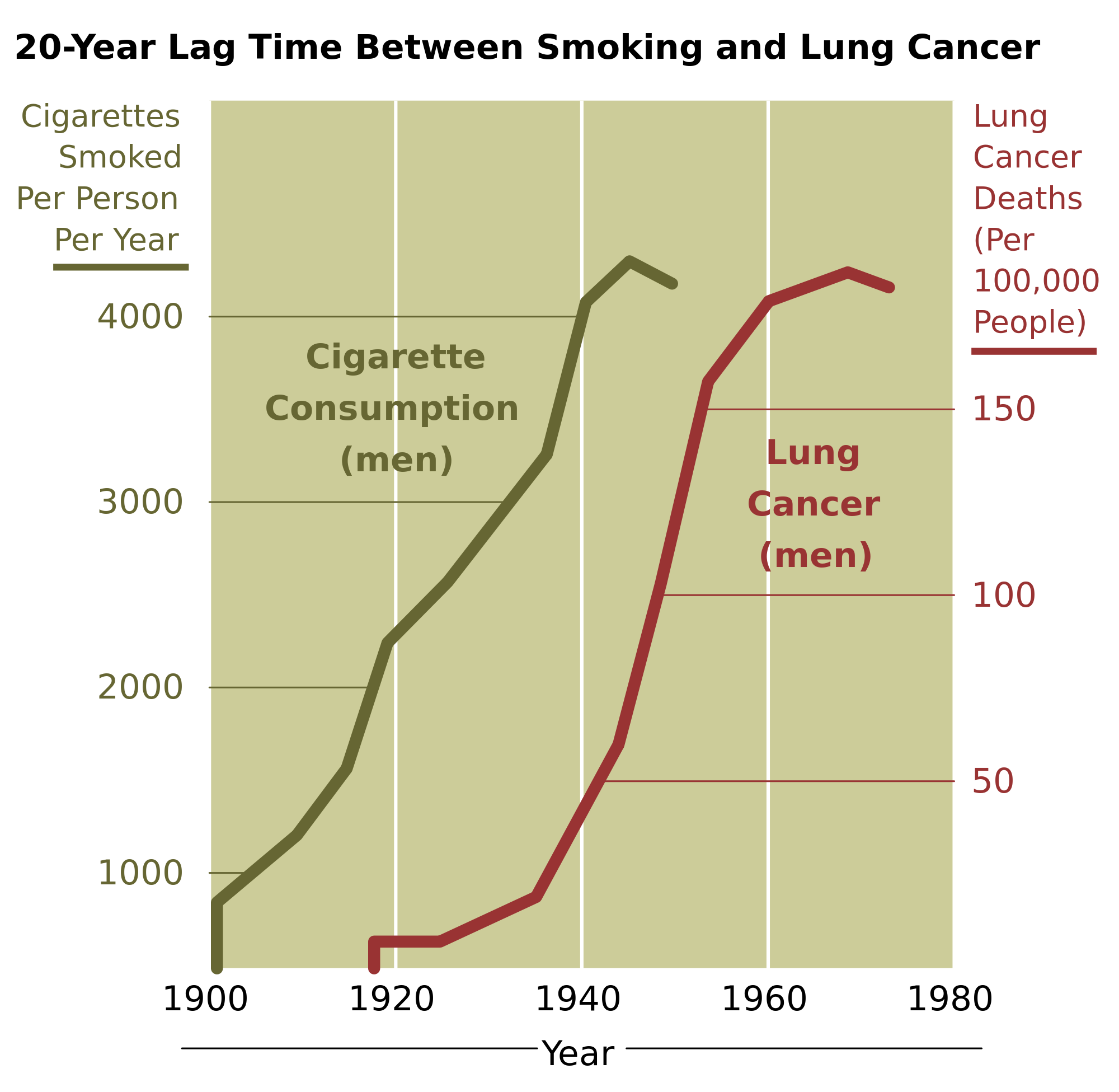
When you consider the composition of tobacco smoke, it’s not surprising that it increases the risk of cancer. Tobacco smoke contains dozens of chemicals proven to be carcinogens, or causes of cancer. Many of these chemicals bind to DNA in a smoker’s cells, and may either kill the cells or cause mutations. If the mutations inhibit programmed cell death, the cells can survive to become cancer cells. Some of the most potent carcinogens in tobacco smoke include benzopyrene, acrolein, and nitrosamines. Other carcinogens in tobacco smoke are radioactive isotopes, including lead-210 and polonium-210.
Respiratory Effects of Smoking
Long-term exposure to the compounds found in cigarette smoke — such as carbon monoxide and cyanide — are thought to be responsible for much of the lung damage caused by smoking. These chemicals reduce the elasticity of alveoli, leading to chronic obstructive pulmonary disease (COPD). COPD is a permanent, incurable, and often fatal reduction in the capacity of the lungs, reducing the lungs' ability to fully exhale air. The chronic inflammation that is also present in COPD is exacerbated by the tobacco smoke carcinogen acrolein and its derivatives. COPD is almost completely preventable simply by not smoking and by also avoiding secondhand smoke.
Cardiovascular Effects of Smoking
Inhalation of tobacco smoke causes several immediate responses in the heart and blood vessels. Within one minute of inhalation of smoke, the heart rate begins to rise, increasing by as much as 30 per cent during the first ten minutes of smoking. Carbon monoxide in tobacco smoke binds with hemoglobin in red blood cells, thereby reducing the blood’s ability to carry oxygen. Hemoglobin bound to carbon monoxide forms such a stable complex that it may result in a permanent loss of red blood cell function. Several other chemicals in tobacco smoke lead to narrowing and weakening of blood vessels, as well as an increase in substances that contribute to blood clotting. These changes increase blood pressure and the chances of a blood clot forming and blocking a vessel, thereby elevating the risk of heart attack and stroke. A recent study found that smokers are five times more likely than non-smokers to have a heart attack before the age of 40.
Smoking has also been shown to have a negative impact on levels of blood lipids. Total cholesterol levels tend to be higher in smokers than non-smokers. Ratios of “good” cholesterol to “bad” cholesterol tend to be lower in smokers than non-smokers.
Additional Adverse Health Effects of Smoking
A wide diversity of additional adverse health effects are attributable to smoking. Here are just a few of them:
- Smokers are at significantly increased risk of developing chronic kidney disease (in addition to kidney cancer). For example, smoking hastens the progression of kidney damage in people with diabetes.
- People who smoke — especially the elderly — have a greater risk of influenza and other infectious diseases than non-smokers. Smoking more than 20 cigarettes a day has been found to increase the risk of infectious diseases by as much as four times the risk in non-smokers. These effects occur because of damage to both the respiratory system and the immune system.
- In addition to oral cancer, smoking causes other oral problems, including periodontitis (gum disease). Roughly half of the cases of gum inflammation are attributable to current or former smoking. This inflammation increases the risk of tooth loss, which is also higher in smokers than non-smokers. In addition, smoking stains the teeth and causes halitosis (bad breath).
- Smoking is a key cause of erectile dysfunction (ED), probably because it leads to narrowing of arteries in the penis, as it does elsewhere in the body. The incidence of ED is about 85 per cent higher in males who smoke than it is in non-smokers.
- Smoking also has adverse effects on the female reproductive system, potentially causing infertility, in part because it interferes with the body’s ability to produce estrogen. Female smokers are about 60 per cent more likely to be infertile than non-smokers. Pregnant women who smoke or are exposed to secondhand smoke have a higher risk of miscarriages and low-birth-weight infants.
- Certain therapeutic drugs, including some antidepressants and anticonvulsants, are less effective in smokers than in non-smokers. This occurs because smoking increases levels of liver enzymes that break down the drugs.
- Smoking causes an estimated ten per cent of all fire-related deaths worldwide. Smokers are also at a greater risk of dying in motor vehicle crashes and other accidents.
- Smoking leads to an increased risk of bone fractures, especially of the hip. It also leads to slower wound healing after surgery, and an increased rate of postoperative complications.
Feature: Human Biology in the News

The item in Figure 13.6.4 looks like a regular cigarette, but it’s actually an electronic cigarette, or e-cigarette. E-cigarettes are battery-powered devices that change flavored liquids and nicotine into vapor that the user inhales. E-cigarettes are often promoted as being safer than traditional tobacco products, and their use is touted as a good way to quit smoking. They are often not banned in smoke-free areas, where it is illegal to smoke tobacco cigarettes.
A study completed in 2015 by researchers at the Harvard School of Public Health and widely reported in the mass media found that e-cigarettes may, in fact, be very harmful to the user’s health. E-cigarettes contain nicotine and cancer-causing chemicals, such as formaldehyde. According to the study, about three-quarters of flavored e-cigarettes also contain a chemical called diacetyl that causes an incurable and potentially fatal disorder of the lungs, commonly called “popcorn lung” (bronchiolitis obliterans). In this disorder, the bronchioles compress and narrow due to the formation of scar tissue, greatly diminishing the breathing capacity of people with the disorder. Popcorn lung gained its common name in 2004, when it was diagnosed in workers at popcorn factories. The buttery flavoring used in the factories contained diacetyl.
Some manufacturers of e-cigarettes and flavorings advertise that their products are now free of diacetyl. However, because e-cigarettes are not currently regulated by the FDA, there is no way of knowing for sure whether the products are actually safe. Equally disturbing is the appeal of flavored e-cigarettes to teens and producers' attempts to specifically market their products to this age group. Flavors such as “cotton candy,” “Katy Perry’s cherry,” and “alien blood” are obviously marketed to youth. Not surprisingly, the use of e-cigarettes is on the rise in middle and high school students, who are more likely to use them than regular cigarettes. Public health officials fear that e-cigarettes will be a gateway for teens to move on to smoking tobacco cigarettes. Some U.S. states have recently passed laws prohibiting minors from buying e-cigarettes, and Brazil, Singapore, Uruguay, and India have banned e-cigarettes. E-cigarettes were not initially regulated by Health Canada because they don't contain nicotine, which made them illegal to sell, but this was not widely enforced. However, Canada enacted the Tobacco and Vaping Products Act (TVPA) on May 23, 2018. As more questions are raised about their potential negative health effects, it is likely that more laws will be passed to regulate e-cigarettes. Watch the news for updates on this issue.
13.6 Summary
- Smoking is the single greatest cause of preventable death worldwide. It has adverse effects on just about every body system and organ. Tobacco smoke affects not only smokers, but also non-smokers who are exposed to secondhand smoke. The nicotine in tobacco is highly addictive, making it very difficult to quit smoking.
- A major health risk of smoking is cancer of the lungs. Smoking also increases the risk of many other types of cancer. Tobacco smoke contains dozens of chemicals known as carcinogens.
- Smoking is the primary cause of chronic obstructive pulmonary disease (COPD). Chemicals such as carbon monoxide and cyanide in tobacco smoke reduce the elasticity of alveoli so the lungs can no longer fully exhale air.
- Smoking damages the cardiovascular system and increases the risk of high blood pressure, blood clots, heart attack, and stroke. Smoking also has a negative impact on levels of blood lipids.
- A wide diversity of additional adverse health effects are attributable to smoking, such as erectile dysfunction, female infertility, and slow wound healing.
13.6 Review Questions
- Create a pamphlet aimed at informing teenagers about the dangers of smoking. Include information about numbers of deaths associated with smoking, life expectancy of smokers, and long term healthy effects of smoking and exposure to second-hand smoke. Include a section on the chemicals present in tobacco smoke and e-cigarettes and some of the adverse affects associated with these chemicals.
- What smoking-related factors determine how smoking affects a smoker’s health?
- What are the two sources of secondhand cigarette smoke? How does exposure to secondhand smoke affect non-smokers?
- Why is it so difficult for smokers to quit the habit? How is their health likely to be affected by quitting?
- Why does smoking cause cancer? List five types of cancer that are significantly more likely in smokers than non-smokers.
- Explain how smoking causes COPD.
- Do you think e-cigarettes can be addictive? Explain your reasoning.
13.6 Explore More
https://www.youtube.com/watch?v=lgVvnnnawvw&feature=emb_logo
Blowing Smoke: The Lost Legacy of the Surgeon General's Report | Alan Blum | TEDxTuscaloosa, TEDx Talks, 2015.
https://www.youtube.com/watch?v=QL2-EsjfiAU
The dangers of vaping, RWJ Barnabas Health, 2019.
Attributions
Figure 13.6.1
Cigarette by Uitbundig on Unsplash is used under the Unsplash License (https://unsplash.com/license)
Figure 13.6.2
Risks_from_smoking-smoking_can_damage_every_part_of_the_body by CDC on Wikimedia Commons is in the public domain (https://en.wikipedia.org/wiki/Public_domain).
Figure 13.6.3
Cancer_smoking_lung_cancer_correlation_from_NIH.svg by Sakurambo on Wikimedia Commons is in the public domain (https://en.wikipedia.org/wiki/Public_domain).
Figure 13.6.4
An_Electronic_Cigarette_(11359245033) by Lindsay Fox from Newport beach, United States on Wikimedia Commons is used under a CC BY 2.0 (https://creativecommons.org/licenses/by/2.0) license.
References
Allen, J. G., Flanigan, S. S., LeBlanc, M., Vallarino, J., MacNaughton, P., Stewart, J. H., Christiani, D.C. (2016, June 1). Flavoring chemicals in E-Cigarettes: Diacetyl, 2,3-Pentanedione, and Acetoin in a sample of 51 products, including fruit-, candy-, and cocktail-flavored E-cigarettes [online article]. Environmental Health Perspectives, 124:733–739. https://doi.org/10.1289/ehp.1510185
Health Canada. (2015). Dangers of second-hand smoke [online article]. Government of Canada. https://www.canada.ca/en/health-canada/services/smoking-tobacco/avoid-second-hand-smoke/second-hand-smoke/dangers-second-hand-smoke.html
RWJ Barnabas Health. (2019, September 25). The dangers of vaping. YouTube. https://www.youtube.com/watch?v=QL2-EsjfiAU&feature=youtu.be
TEDx Talks. (2015, August 7). Blowing smoke: The lost legacy of the surgeon general's report | Alan Blum | TEDxTuscaloosa. https://www.youtube.com/watch?v=lgVvnnnawvw&feature=youtu.be
Tobacco and Vaping Products Act. (2016, June 26). Government of Canada. https://www.canada.ca/en/health-canada/services/health-concerns/tobacco/legislation/federal-laws/tobacco-act.html
Vaping, E-cigarettes to be regulated by Health Canada. (2016, November 22). CBC/Radio-Canada. HTTP://www.cbc.ca/news/health/vaping-health-canada-legislation-1.3862589
Wikipedia contributors. (2020, August 9). Regulation of electronic cigarettes. In Wikipedia. https://en.wikipedia.org/w/index.php?title=Regulation_of_electronic_cigarettes&oldid=972059825
A molecule that can undergo polymerization, creating macromolecules. Large numbers of monomers combine to form polymers in a process called polymerization.
A hormone that is produced in humans by the parafollicular cells (commonly known as C-cells) of the thyroid gland. Calcitonin is involved in helping to regulate levels of calcium and phosphate in the blood, opposing the action of parathyroid hormone.
Refers to the relationship between two versions of a gene. Individuals receive two versions of each gene, known as alleles, from each parent. If the alleles of a gene are different, one allele will be expressed; it is the dominant gene. The effect of the other allele, called recessive, is masked.
A hormone that is produced in humans by the parafollicular cells (commonly known as C-cells) of the thyroid gland. Calcitonin is involved in helping to regulate levels of calcium and phosphate in the blood, opposing the action of parathyroid hormone.
A genetically-based trait that has evolved because it helps living things survive and reproduce in a given environment.
Image shows a photograph of a humidifier emitting mist.
A threadlike structure of nucleic acids and protein found in the nucleus of most living cells, carrying genetic information in the form of genes.
A mature haploid male or female germ cell which is able to unite with another of the opposite sex in sexual reproduction to form a zygote.
Image shows to small children in a backyard wading pool. One adult is standing by the pool resting their foot on the edge and another adult is sitting nearby in a lawn chair.
Image shows a comparison of healthy bronchial tubes and bronchial tubes with bronchitis. The tubes with bronchitis have inflamed walls and increased amounts of mucous, substantially decreasing the pathway for air.
Biological molecules that lower amount the energy required for a reaction to occur.
A class of molecules that includes the non-steroid hormones produced by the medulla of the adrenal gland, such as adrenaline, that stimulate the fight-or-flight response.
A sequence of nucleotides in DNA or RNA that codes for a molecule that has a function.
The smallest unit of life, consisting of at least a membrane, cytoplasm, and genetic material.
A class of biological molecule consisting of linked monomers of amino acids and which are the most versatile macromolecules in living systems and serve crucial functions in essentially all biological processes.
A class of molecules that includes the non-steroid hormones produced by the medulla of the adrenal gland, such as adrenaline, that stimulate the fight-or-flight response.

